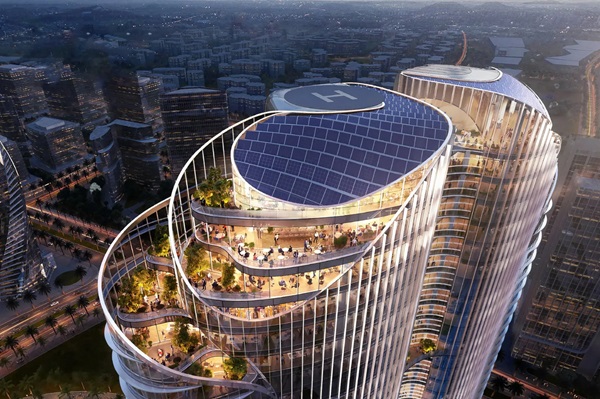
Forbes is set to construct a 50-storey hydrogen-powered building in Egypt, the first of its kind in Africa. This groundbreaking project represents a significant leap in hydrogen innovation and promises to pave the way for more sustainable skyscrapers across the continent.
SPECIAL REPORT | BIRD AGENCY | Egypt is racing ahead in Africa’s hydrogen innovation with the launch of the continent’s first ‘Hydrogen Building,’ a 50-floor skyscraper. This development could unlock new hydrogen application niches as pipeline capacity expands across Africa, driven by increasing investments in the sector.
Forbes and Magnom Properties, a Saudi-Arabian real estate company, announced the partnership for the US$1 billion skyscraper in 2023 on the sidelines of the 53rd Annual Meeting of the World Economic Forum (WEF) in Davos, Switzerland.
According to Forbes CEO Mike Federle, this will be “the first sustainable international tower under the Forbes name.”
The tower will be located in the heart of Cairo’s rising New Administrative Capital. Construction is expected to commence in 2025 and be completed by 2030.
According to Adrian Smith, the project’s lead architect, the final structure will be “a contextually responsive soaring glass, steel, and photovoltaic-laced design featuring captivating curves of glass and steel that launch skyward to form 55 floors of flexible office space and two stories of high-end retail experiences.”
However, beyond its architectural and economic relevance, the project marks a vital stride in Africa’s diversification of the application and use of hydrogen, whose capacity stands at more than 114GW spread across 52 projects, according to Rystad Energy.
In Egypt, hydrogen is an energy-focused area with ambitions to produce and potentially distribute it to Europe via the strategic Suez Canal.
Egypt recently unveiled a green hydrogen strategy, outlined by the government as its goal of being one of the leaders in exporting green hydrogen by 2040.
This strategy has reaffirmed its commitment to developing the sector and attracting more investors.
The World Economic Forum reports that Egypt is seeking up to US$40 billion of investment in green hydrogen. In its latest effort to attract investors, Egypt has signed seven memoranda of understanding with different investors.
The growing investor interest in Egypt mirrors ongoing developments in multiple other countries, especially in the southern African region, where Namibia and South Africa are seeing the most investor activity.
A June report by the UN Trade and Investment revealed green hydrogen was among the leading subsectors in the clean energy sector that attracted most investors in 2023.
Also, recent years have seen Africa’s skyline undergo notable changes as the demand for iconic towers grows. Beyond countries such as South Africa, Kenya, and Egypt, new highrises are emerging in relatively new markets such as Zanzibar.
However, according to architecttours.com, “skyscrapers have proven to increase energy consumption, the heat island effect, microclimate, CO2 emissions, and by extension climate change crises.”
A 2022 report, the Global Status Report for Buildings and Construction, found that emissions from buildings accounted for 34% of energy demand and up to 37% of energy-related emissions as of 2021.
A 30-storey structure emits at least 300,000 tonnes of greenhouse gas emissions equivalent to emissions from close to 40000 standard homes’s energy use for a whole year.
However, with an abundance of green hydrogen potential, Africa can push for more ambitious skyscrapers while significantly cutting emissions from not only their construction but also in the post-construction phase through fittings and appliances that use clean energy.
The shift towards sustainable highrises is already gaining ground, exemplified by Burj Zanzibar. This US$1.3 billion high-rise is under construction on the archipelago island using hybrid timber instead of concrete. Completion is slated for 2026.
The proposed Forbes Tower project adds to the growing interest in innovating and diversifying the use of hydrogen for purposes beyond conventional applications.
Beyond Egypt, the common target use of green hydrogen has been primarily in industrial applications as a substitute for dirty fuel and, more recently, in the transport sector.
Namibia is already on course to construct Africa’s first public green hydrogen fueling station at Walvis Bay on the western coast. The station will supply green hydrogen for heavy-duty trucks.
Investors such as BMW, which launched a test vehicle using hydrogen fuel earlier this year, have also expressed confidence in using green hydrogen in the transport sector.
Other automakers have also shown interest in the commercial application of hydrogen in mobility, including Japanese carmaker Toyota, which has already launched Mirai, a US$50,000 model in the US.
German research firm McKinsey & Company projects that Africa could generate up to 60 megatons of green hydrogen by 2050, both for domestic and export markets.
*****
SOURCE: bird story agency
 The Independent Uganda: You get the Truth we Pay the Price
The Independent Uganda: You get the Truth we Pay the Price



